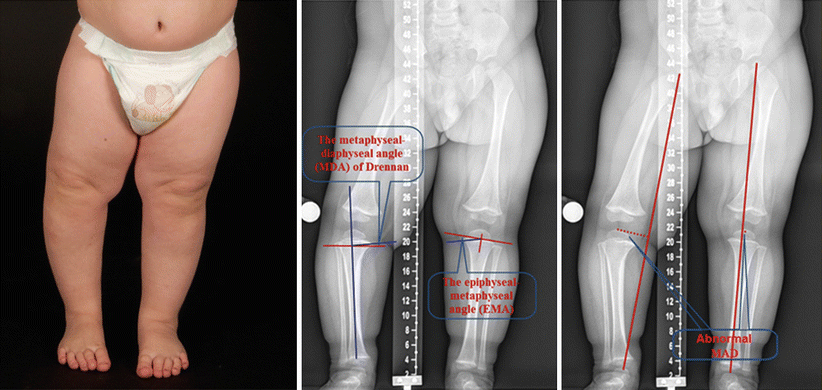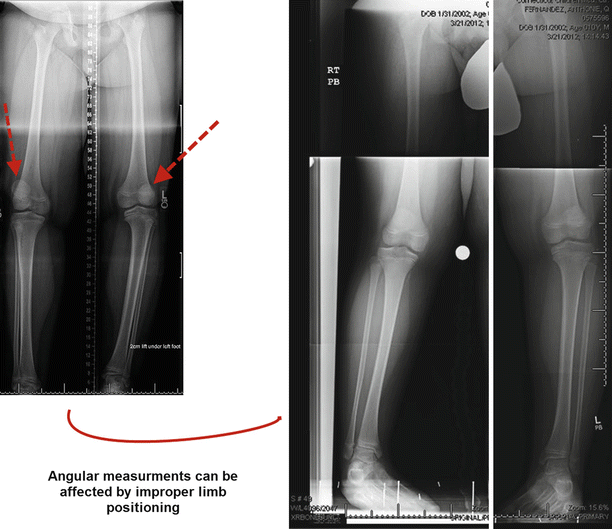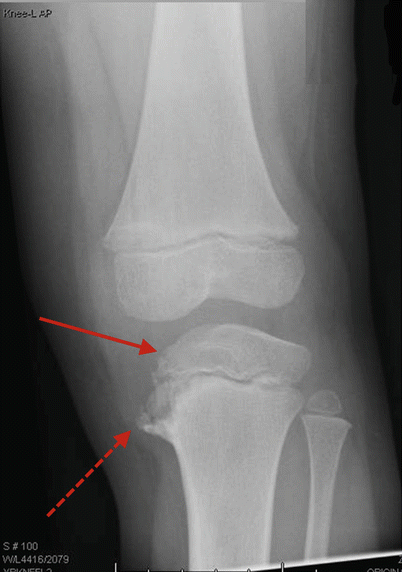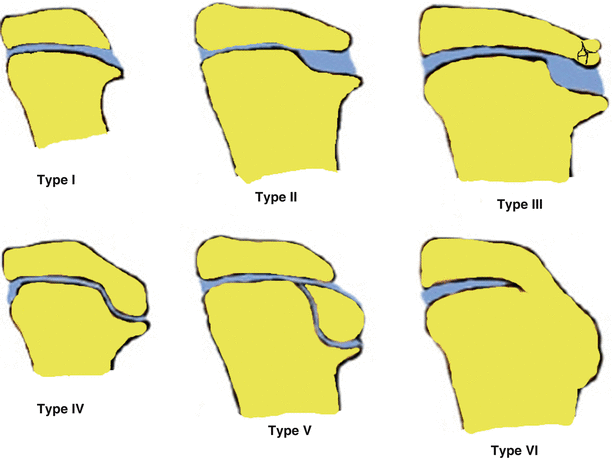Fig. 14.1
Salenius curve
Toddlers under age 2 years should be followed clinically until resolution as long as alignment is improving, even if not on the expected schedule.
Indications for radiographs include asymmetry between right and left sides, lack of improvement with time, or a varus thrust with ambulation. After age 18 months, we obtain a digital mechanical axis view, which consists of a standing anteroposterior radiograph of the bilateral lower extremities from the hips to the ankles with the patellae facing forward. This is used to measure the tibiofemoral (TFA), mechanical axis deviation (MAD) metadiaphyseal of Drennan (MDA), and epiphyseal-metaphyseal angles (EDA) of the tibia.
The tibiofemoral angle (TFA) is formed by the intersection of the two mid-diaphyseal lines of the femur and the tibia. The value should be within the normal range depicted by Salenius curve. MAD is the distance between the mechanical axe and the centre of the knee (the anatomic axes cross the knee almost at the centre). The normal mechanical axes pass 8 ± 7 mm medial to the centre of the knee. It is valuable in follow up of these patients. I need to see the mechanical axes approaching its normal pass through the knee.
The metadiaphyseal angle (MDA) is the angle formed by a line connecting the most distal point on the medial and lateral beaks of the proximal tibial metaphysis and a line perpendicular to the anatomic axis (or lateral cortex) of the tibia.
Levine and Drennan [1] found that in 29 of 30 legs with an initial MDA of more than 11°, radiographic changes of idiopathic tibia vara (Blount’s disease) later developed whereas such changes developed in only 3 of 58 patients with an angulations of 11° or less.
The epiphyseal–metaphyseal angle (EMA) is determined by measuring the angle formed by a line through the proximal tibial physis parallel to the base of the epiphyseal ossification center and a line connecting the midpoint of the base of the epiphyseal ossification center with the most distal point on the medial beak of the proximal tibial metaphysis (Fig. 14.2).


Fig. 14.2
Radiograhic measurments in Blounts diseases. The TFA is the angle the femoral and tibial mid-diaphyseal. MAD is the distance between the mechanical axe and the centre of the knee. The MDA is the angle formed by a line connecting the most distal point on the medial and lateral beaks of the proximal tibial metaphysis and a line perpendicular to the anatomic axis (or lateral cortex) of the tibia. The EMA is the angle formed by a line through the proximal tibial physis parallel to the base of the epiphyseal ossification center and a line connecting the midpoint of the base of the epiphyseal ossification center with the most distal point on the medial beak of the proximal tibial
Davids et al. [2] studied the knee x-rays of 80 children who were less than 3 years old. They found children with MDA >10° and EMA >20° are at greater risk for development of Blount disease and should be followed closely. In their series, none of the children with MDA <10° and EMA <20° developed Blount disease.
Angular measurements are altered by limb rotation, which is why proper positioning is paramount (Fig. 14.3 ).


Fig. 14.3
The affect of limb position on angular meaurments. Left: standing limb alignment film of a 10 year old male demonstrating apparent bilateral overall varus angulation, however the patellae are not facing forward (dashed arrows). Right: the same patient was imaged on separate cassettes with the feet rotated in until the patellae faced forward, which improves the varus appearance
Infantile Blount’s is confirmed with a widened irregular medial proximal tibial physis with metaphyseal beaking (Fig. 14.4). Lateral tibial subluxation, lucent areas within the metaphyseal beak, and triangular ossification of the epiphysis may also be present.


Fig. 14.4
Radiographic features of infantile Blounts. An AP of the left knee demonstrates a widened proximal tibial physis, sloped epiphysis (solid arrow), metaphyseal beaking with lucent areas (dashed arrow), and subluxation of the tibia indicating lateral instability
The differential diagnosis includes skeletal dysplasia, metabolic disease, physeal disturbance from occult trauma or infection, or, rarely, focal fibrocartilaginous dysplasia. History, a skeletal survey, and lab work helps differentiate these conditions.
What Is Infantile Blount’s?
When genu varum presents before age 3 and is determined to result from altered growth from the medial proximal tibial epiphysis, it is termed infantile Blount Disease [3]. Microscopically, the physis is disordered, with resultant abnormal endochondral ossification in the metaphysis causing a progressive varus as asymmetric lateral growth continues. The etiology is unknown and generally thought to be developmental, rather than congenital, as presentation before age 2 is rare [4].
Unlike physiologically bowed patients, patients with infantile Blounts tend to be obese and have a lateral thrust during gait. Each whole number increase in BMI increases the likelihood of Blount disease by 3 % [5]. Higher body mass index (BMI) has also been correlated with greater severity of varus and procurvatum deformity in this population. Additionally, patients may have marked intoeing, due to a combination of increased internal tibial torsion and femoral anteversion [6].
Langenskiold [7] divided patients into six stages according to age and radiographic metaphyseal and epiphyseal changes (Fig. 14.5). This classification has proven to be prognostic in certain populations, with resolution possible prior to stage 4, after which recurrence is likely. In nonwhite populations, however, stages can occur earlier and disease can progress despite treatment before age 4. Timing and type of treatment, therefore, must be tailored to the population being treated.


Fig. 14.5
Langenskiold staging of Blounts disease. Type I: Medial beaking, irregular medial ossification with protrusion of the metaphysis. Type II: Cartilage fills depression. Progressive depression of medial epiphysis with the epiphysis slopes medially as disease progress. Type III: Ossification of the inferomedial corner of the epiphysis. Type IV: Epiphyseal ossification filling the metaphyseal depression. Type V: Double epiphyseal plate (cleft separating two epiphyses). Type VI: Medial physeal closure
What Is the Best Nonoperative Treatment for Infantile Blounts?
A knee ankle foot orthosis (KAFO) or hip knee ankle foot orthosis (HKAFO) provides 3-point valgus pressure and can be considered in younger than age 3 or prior to Langenskiold stage II. An elastic Blount brace is a low profile option that utilizes an elastic band distally to provide the valgus force in conjunction with a medial upright, with drop locks to increase corrective force during weight bearing [4]. Bracing schedules vary from full time to day or night only, with frequent adjustment of the medial upright every couple months to provide a continuous valgus force.
There is a narrow window for nonoperative treatment, as diagnosis is often made after age two, and to allow a 1-year trial without delaying surgery requires initiation before age 3. If neutral mechanical axis and healing of the radiographic Blounts lesion do not occur, corrective osteotomy should be performed prior to age 4. Surgery at earlier stage of disease is prognostic of higher success. At stage 4 and beyond, permanent physeal arrest is more likely.
The success of true bracing effect is confounded by the benign natural history of physiologic bowed legs treated as Blounts. One study limited to patients with Drennan’s angles over 16° showed 86 % success. Bracing failure was more likely with ligamentous instability, body weight exceeding the 90th percentile, or late initiation [8]. Another study demonstrated 70 % success in Langenskiold stage II disease, though this was mainly in unilateral disease. Seventy percent of patients with bilateral involvement required surgical management [9].
What Is the Best Operative Treatment for Infantile Blounts?
Early Stage
The most common surgical approach is a single stage osteotomy to overcorrect the limb into about 5–10° of valgus, with concomitant lateral translation to ensure the mechanical axis passes laterally (Fig. 14.6). This removes the medial compressive forces to unload the sick medial physis and allow resumption of growth. Osteotomy can be performed with opening or closing wedges or a dome type. Staying distal to the patellar tendon avoids physeal damage that would result in recurvatum. External rotation of the distal fragment is often needed, and judged pre and intraoperatively by assessment of bimalleolar and thigh foot (or heel thigh) axes.


Fig. 14.6
Corrective osteotomy for infantile Blounts disease. Left: standing alignment film in a 4 year old male demonstrates mechanical axis going through the center of the knee joint on the right lower extremity while deviated medially on the right side. Middle: patient underwent acute tibial and fibular osteotomies through separate incisions to produce valgus, lateral translation, and external rotation of the distal fragment, with percutaneous K wire fixation, prophylactic anterior compartment fasciotomy, and long leg casting. Right: Postoperative radiographs demonstrating healed osteotomy, desired valgus overcorrection, and restoration of mechanical axis
Additional considerations include fibular osteotomy, fixation, and fasciotomy. Given the small but real risk of compartment syndrome, long leg casts are often bivalved to allow room for postoperative swelling. Percutaneous or internal fixation is therefore recommended, as cast loosening can result in loss of external stability. K wire fixation is most often employed. Prophylactic 3 compartment fasciotomy can be considered, and we perform this routinely. Despite these measures, subtle weakness of the extensor hallucis longus can still be observed, likely due to partial peroneal nerve palsy [4].
Stay updated, free articles. Join our Telegram channel

Full access? Get Clinical Tree







